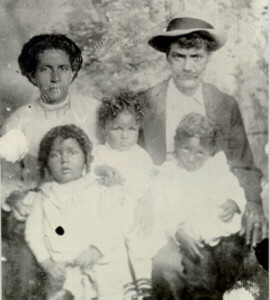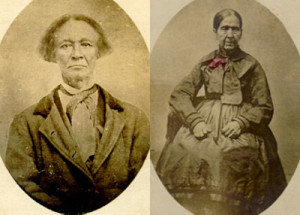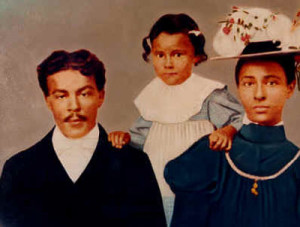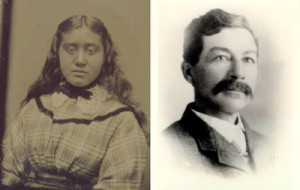For several decades, genealogist Paul Heinegg has been searching through the state archives of Virginia, North Carolina, Maryland, and Delaware, looking for records about the lives of free African Americans before 1820. While he has published his findings, which are also available on his Website, www.freeafricanamericans.com, academic historians may have missed them and their challenge to typically held notions of the origins and history of free African Americans in early American history. For example, Heinegg’s work reveals that most free African American families that originated in colonial Virginia and Maryland descended from white servant women who had children by slaves or free African Americans, and many descended from slaves who were freed before the 1723 Virginia law requiring legislative approval for manumissions. Perhaps most intriguingly, Heinegg has found that very few families that were free during the colonial period descended from white slave owners who had children by their slaves, perhaps as few as one percent of the total.
The principal sources for Virginia, North Carolina, and Maryland were all the surviving colonial county court order and minute books on microfilm–nearly a thousand manuscript volumes. Also important were the colonial and early national tax lists, deeds, wills and estate accounts, late-eighteenth to early nineteenth-century free Negro Registers, marriage bonds, colonial parish registers, census records, newspapers, and Revolutionary pension files. The sources encompass virtually every surviving public document relating to these families. The county court records give us a glimpse of the daily life of the ordinary people in the county. They include apprentice indentures (which usually contain the name, age, and parent[s] of the apprentice), suits for debt, and charges for various offenses. Many families appear in colonial deeds and wills without racial designation. Their African ancestry–and often their origin–is revealed only in their conviction by the court for the violation of a race-based law.

Virginia
When they arrived in Virginia, Africans joined a society that was divided between master and white servant, a society with such contempt for white servants that masters were not punished for beating them to death. They joined the same households with white servants–working, eating, sleeping, getting drunk, and running away together. Some of these first African slaves became free. John Geaween (Gowen), “a negro servant,” was free by 1641. Francis Payne of Northampton County paid for his freedom about 1650 by purchasing three white servants for his master’s use. Emanuell Cambow (Cumbo), “Negro,” was granted fifty acres in James City County in 1667. John Harris, “negro,” was free by 1668 when he purchased fifty acres in York County.
A number of men and women of African descent living on the Eastern Shore gained their freedom in the seventeenth century. There were at least thirty-three African Americans in Northampton County in the 1670s who were free, later became free, or had free children. They represented one-third of the taxable African Americans in the county. By the mid-seventeenth century, some free African Americans were beginning to be assimilated into colonial Virginia society. Many were the result of mixed-race marriages. Francis Payne was married to a white woman named Amy by September 1656 when he gave her a mare by deed of jointure. Elizabeth Key, a “Mulatto” woman whose father had been free, successfully sued for her freedom in Northumberland County in 1656 and married her white attorney, William Greensted. Francis Skiper was married to Ann, a African American woman, before February 1667/8 when they sold land in Norfolk County. Peter Beckett, a “Negro” slave taxable from 1671 to 1677 in Northampton County, married Sarah Dawson, a white servant. Hester Tate, an English woman servant in Westmoreland County, had several children by her husband James Tate, “a Negro slave to Mr. Patrick Spence,” before 1690.
As the percentage of African Americans in the population increased, so did tension between free African Americans and slaveholders. And as more and more slaves replaced white servants, the legislature passed a series of laws between 1670 and 1723 designating slavery as the appropriate condition for people of African descent. In 1670 free African Americans and Indians were forbidden to own white servants. In 1691 the manumission of slaves was prohibited unless they were transported out of the colony. In addition, interracial marriage was prohibited and the illegitimate, mixed-race children of white women were to be bound out for thirty years. In 1705 church wardens were allowed to seize and sell the farm stock of slaves to support the poor of the parish. And in 1723 the manumission of slaves was prohibited unless they had rendered some public service.
Despite the efforts of the legislature, white servant women continued to bear children by African American fathers through the late seventeenth century and well into the eighteenth century. It appears that they were the primary source of the increase in the free African American population for this period. Over two hundred African American families in Virginia descended from white women. Many of these women may have been the common-law wives of slaves since they had several mixed-race children. Forty-six families descended from freed slaves, twenty-nine from Indians, and sixteen from white men who married or had children by free African American women. It is likely that the majority of the remaining families descended from white women since they first appear in court records in the mid-eighteenth century when slaves could not be freed without legislative approval, and there is no record of legislative approval for their emancipations.
Racial contempt for African Americans did not fully develop as long as there were white servants in similar circumstances. It was during this period, as late as the end of the eighteenth century, that free African Americans were accepted in some white communities. Since so many free African Americans were light skinned, many observers assume that they were the offspring of white slave owners who took advantage of their female slaves. Only three of the approximately 570 families in Virginia and the Carolinas were proven to descend from a white slave owner. They were the children of South Carolina planters, and like their fathers, they were wealthy slave owners who were accepted in white society.

By 1790 free African Americans were concentrated on the Eastern Shore of Virginia, the counties below the James River, and the northeastern part of North Carolina. This was a pattern of settlement similar to that of newly freed white servants. Land was available in Southside Virginia and in the northeastern part of North Carolina at prices former servants could afford.
In 1782 Virginia relaxed its restrictions on manumission, but the descendants of families which had been free during the colonial period continued to comprise a major part of the free African American population due to natural increase. In 1810 the Going/Gowen family, free since the mid-seventeenth century, headed forty “other free” households with 105 persons in Virginia, sixty-two persons in North Carolina, eleven in South Carolina, and ten in Louisiana. The Chavis family, free since the seventeenth century, headed forty-one households containing forty-six persons in Virginia, 159 in North Carolina, and twelve in South Carolina.
North Carolina
In 1712 all fifteen members of the Anderson and Richards families were freed and given 640 acres in Norfolk County, Virginia, by the will of John Fulcher, creating such a stir that the legislative council on March 5, 1712/3, proposed that the assembly “provide a Law against such Manumission of Slaves, which in time by their increase and correspondence with other slaves may endanger the peace of this Colony.” In an effort to “prevent their correspondence with other slaves,” Fulcher’s executor, Lewis Conner, by a deed dated March 20, 1712/3, swapped their land in Norfolk County with land on Welshes Creek in Chowan County, North Carolina.
Many of those who were free in Northampton County, Virginia, settled in Craven County, North Carolina. James and Peter Black came to Craven County from Essex County, Virginia, where they had been free born. John Heath tried to sell them as slaves to William Handcock, but the Craven County court intervened on their behalf in 1745. Moll, Nell, Sue, Sall, and Will Dove, “Negroes,” came to Craven County from Maryland with Leonard Thomas, who was trying to keep them as his slaves in 1749, but William Smith traveled to Maryland and proved their claim that they were free born. The descendants of Nicholas and Bungey Manuel, “negro slaves” freed by the 1718 will of Edward Myhill of Elizabeth City County, Virginia, were in the Edgecombe County, North Carolina, militia in the 1750s.
The family histories of over 80 percent of the heads of families counted as “all other free persons” in the 1790-1810 federal censuses for North Carolina indicate that they were descendants of African Americans who were free in Virginia during the colonial period.
Free African American immigrants were of sufficient number in 1723 that the North Carolina general assembly received complaints “of great Numbers of Free Negroes, Mulattoes, and other persons of mixt Blood, that have lately removed themselves into this Government, and that several of them have intermarried with the white Inhabitants of this Province.”

While some North Carolina residents were complaining about the immigration of free African Americans, their white neighbors in Granville, Halifax, Bertie, Craven, Granville, Robeson, and Hertford counties welcomed them. In 1762 many of the leading residents of Halifax County petitioned the assembly to repeal the discriminatory tax against free African Americans, and in 1763 fifty-four of the leading citizens of Granville, Northampton, and Edgecombe counties made a similar petition. They described their “Free Negro & Mulatto” neighbors as “persons of Probity & good Demeanor [who] chearfully contribute towards the Discharge of every public Duty injoined them by Law.” About ten years later a similar petition by seventy-five residents of Granville County included those of a few of the free African Americans of the county.
During the colonial and early national periods at least one member of most African American families in North Carolina owned land. Land ownership made for closer relations with the white community than with slaves. The McKinnie family, originally from Isle of Wight County, Virginia, was one of the leading white families in the area around the Roanoke River. Barnaby McKinnie, member of the general assembly from Edgecombe County in 1735, was witness to many of the early deeds of African American families. John McKinnie called Cannon Cumbo his friend when he mentioned him in his 1753 Edgecombe County will. Other leading white settlers who sold them land adjoining theirs and witnessed their deeds were Richard Washington, William and Thomas Bryant, Richard Pace, and William Whitehead. Arthur Williams, member of the general assembly for Bertie County in 1735, and John Castellaw, perhaps a brother of James Castellaw, a member of the assembly from Bertie County, had mixed-race common-law wives, Elizabeth and Martha Butler.
By 1790 free African Americans represented 1.7 percent of the free population of North Carolina, concentrated in the counties of Northampton, Halifax, Bertie, Craven, Granville, Robeson, and Hertford where they were about 5 percent of the free population. In these counties most African American families were landowners, and several did exceptionally well. The Bunch, Chavis, and Gibson families owned slaves and acquired over a thousand acres of land on both sides of the Roanoke River in present-day Northampton and Halifax counties, and the Chavis and Gowen families acquired over a thousand acres in Granville County. William Chavis, a “Negro” listed in the 1754 muster roll of Colonel William Eaton’s Granville County Regiment, owned over a thousand acres of land, a lodging house frequented by whites, and eight taxable slaves. His son Philip Chavis also owned over a thousand acres of land. Edward Carter was the fourth largest Dobbs County landowner with 23,292 acres in 1780. He was head of a Dobbs County household of eight “other free,” one white woman, and twenty slaves in 1790. In a most extraordinary move, in 1773 the Dobbs County court recommended to the general assembly that Edward Carter’s daughters be exempted from the discriminatory tax against female children of African Americans.

In mid-eighteenth century North Carolina tax assessors counted wealthy mixed-race families in some years as “mulatto” and in other years as white. Jeremiah and Henry Bunch, Bertie County slave owners, were taxed in Jonathan Standley’s 1764 Bertie County list as “free male Molattors” in 1764, but as whites in Standley’s 1765 Bertie list, and again as “free Molatoes” in 1766. Michael Going/Gowen was taxed in Granville County as white in 1754 and was called “Michael Goin, Mulattoe” in 1759.
Some of the lighter-skinned descendants of these families formed their own distinct isolated communities that have been the subject of anthropological research. Those in Robeson County, North Carolina, are called “Lumbee Indians”; in Halifax and Warren counties: “Haliwa-Saponi”; in South Carolina: “Brass Ankles” and “Turks”; in Tennessee and Kentucky: “Melungeons” and “Portuguese”; and in Ohio: “Carmel Indians.” Several fantastic theories on their origin have been suggested. One is that they were from Raleigh’s lost colony at Roanoke and another that they were an amalgamation of the Siouan-speaking tribes in North and South Carolina. However, the “people of color” in these areas were distinguished from nearby white communities because of a single, common characteristic: their African American ancestry. Indians, both slave and free, who lived among the English, blended into the African American population. They did not form their own communities. Even so, 38 percent of the population of Robeson County had an American Indian identity in the 2000 federal census.
New York and New Jersey
The history of free African Americans families in colonial New York and New Jersey is quite different from Virginia and North Carolina. Most were descended from slaves freed by the Dutch West India Company between 1644 and 1664 or by individual owners. Henry Hoff has studied these families, especially fourteen families he has traced for three generations or more. None of the fourteen families appears to be descended from a white servant woman and a African American man. However, Lutheran church records in the eighteenth century show a few couples like this having children baptized.
Four of the fourteen families began with one white spouse or partner, but only one was a white man who had a child by a slave woman–and their male-line descendants passed into the white population after a few generations of living in Tappan (on the New York-New Jersey border), which had two free African Americans among its original patentees. There was no legal ban to interracial marriage in colonial New York or New Jersey, and in these fourteen families, there were several instances of white men and women marrying African Americans.
The principal sources for New York and New Jersey were the informative records of the Dutch Reformed and Lutheran churches that permitted identification even when racial designations were omitted. For example, Willem Anthonissen, Negro, and Margariet Pieters were married in 1672. A decade later, Willem Anthony, widower of Margariet Pieters, married Maria Claerce, spinster, from England. Moreover, baptismal records of these churches list godparents, sometimes even stating relationships. Several free African Americans were church members and one of them, Arie van Guinee, was a prominent Lutheran layman in New Jersey in the early eighteenth century.
Court records were occasionally useful but not because of racial laws. For example, in 1765 Adam Arey sued Luke Pettersen in New Jersey for £100, and the complaint described the defendant as “a free mulatto fellow [who] lives among a parcel of free negroes somewhere along the North River.”
No Indians were involved with these fourteen families during the colonial era, but descendants of one family appear later in a triracial isolate, the Ramapo Mountain People.
Conclusions
Heinegg’s primary research was in Virginia, North Carolina, and Maryland. The court records for Maryland are extensive but do not contain nearly the information found in Virginia and North Carolina records since relatively few free African Americans owned land in Maryland. Nevertheless, his reconstruction and analysis of Maryland, Delaware, and South Carolina families yields comparable conclusions to Virginia and North Carolina families.
The number of families studied for New York and New Jersey is very small, but limited conclusions can be drawn. Most free African American families descended from freed slaves. There were marriages in the early generations between white women and African American men, but none of the women were identified as servants, perhaps because New York had only a small population of white indentured servants.
Further Reading:
This article is a revised and abbreviated version of Paul Heinegg’s introduction to his work, Free African Americans of Virginia, North Carolina and South Carolina from the Colonial Period to About 1820, 4th ed., 2 vols. (Baltimore, 2001), and is published here with the permission of the publisher, Clearfield Company. See also, Heinegg, Free African Americans of Maryland and Delaware from the Colonial Period to 1810 (Baltimore, 2000). The text of both these works is available at www.freeafricanamericans.com. See also Henry B. Hoff, “Researching African-American Families in New Netherland and Colonial New York and New Jersey,” forthcoming in The New York Genealogical and Biographical Record.
On early free African American communities in Virginia, see Joseph Douglas Deal III, Race and Class in Colonial Virginia: Indians, Englishmen, and Africans on the Eastern Shore During the Seventeenth Century (New York, 1993), and Reginald Dennin Butler, “Evolution of a Rural Free Black Community: Goochland County, Virginia, 1728—1832” (Ph.D. diss., The Johns Hopkins University, 1989). On the history of sexual liaisons between white women and African American men in the South, see Martha Hodes, White Women, Black Men: Illicit Sex in the Nineteenth Century South (New Haven and London, 1997). For tri-racial isolate communities, see Virginia Easley DeMarce, “‘Verry Slitly Mixt’: Tri-Racial Isolate Families of the Upper South–A Genealogical Study,” National Genealogical Society Quarterly 80 (1992): 5-35.
This article originally appeared in issue 5.1 (October, 2004).
Paul Heinegg, a retired engineer, has been researching the history of free African Americans in the southeast for the past seventeen years, with an emphasis on the colonial period.
Henry B. Hoff, editor of the New England Historical and Genealogical Register, has written on free African Americans in early New York and New Jersey.



















